SICOT e-Newsletter
Issue No. 70 - October 2014
History of Orthopaedics
Brief History of IlizarovAlexander Gubin
SICOT Active Member - Kurgan, Russia
Shalin Maheshwari
SICOT Associate Member - Mumbai, India
It is impossible to briefly describe the history of Prof Gavriil A. Ilizarov (1921-1992), world-renowned orthopaedic and trauma surgeon and inventor of his own new method and device of external fixation, and his contribution to Orthopaedics.
Ilizarov was born in the town of Bialowieza, Poland, to a Mountain Jewish family from the Dagestan region of the Russian Empire. Soon after his birth, the family moved to Qusar (Azerbaijan), where he grew up. He graduated from Derbent Medical Rabfac (an educational establishment set up to prepare workers and peasants for higher education) and then from Crimea Medical School. He has done great work in traumatology and orthopaedics and has received many national and international awards. He was a member of the Academy of Medical Sciences of USSR, Society of the Inventors and Innovators of USSR, and Editor of the Journal 'Orthopaedics, Traumatology and Prosthetics' (USSR). 52 dissertations by candidates of medical science degrees and 7 doctoral theses were prepared and presented under his supervision. 208 inventions (USSR author certificates) including 18 inventions patented in 10 countries were approved.
Brief chronicle of events of Ilizarov history are given below:
1944 â G.A. Ilizarov started his career as a general surgeon in a small village hospital of the Kurgan region.
1952 â G.A. Ilizarov obtained an author's certificate for 'the Method of bone healing in fractures and the apparatus for implementation of this method'. Also, the first article about Ilizarov and the limb lengthening for 12.5 cm was published in the newspaper 'Red Kurgan'.
1953 â The USSR Ministry of Health permitted the application of the Ilizarov apparatus.
1965 â G.A. Ilizarov was appointed the head of the laboratory of the Sverdlovsk Scientific Research Institution of Traumatology and Orthopaedics.
1968 â G.A. Ilizarov's dissertation on 'Compression Osteosynthesis using the Author's Apparatus (experimental and clinical study)' was presented.
1968 â The Olympic high jump champion, Valery Brumel, came for treatment to the Ilizarov Centre in Kurgan.
1969 â The USSR Ministry of Health and the Committee on Inventions of Medical Apparatus of the Ministry decided to rename the apparatus which he had invented as the Ilizarov apparatus.
1971 â The branch of the Leningrad Scientific Research Institution of Traumatology and Orthopaedics was reorganised into the Kurgan Scientific Research Institution of Experimental and Clinical Orthopaedics and Traumatology (KSRIECOT).
1972 â The first issue of the collection of scientific works of the KSRIECOT 'Transosseous compressive and distraction osteosynthesis in traumatology and orthopaedics' was published.
1976 â Russian Congress on the Ilizarov method 'Theoretical and Practical Aspects of Transosseous Compression and Distraction Osteosynthesis'.
1978 â G.A. Ilizarov was awarded 'The Order of the Smile' & the Lenin Prize.
1980 â The well-known Italian explorer Karlo Mauri came for treatment to the Kurgan Research Institute of experimental and clinical orthopaedics and traumatology. His treatment made G.A. Ilizarov famous outside of Russia and drew the attention of international patients and surgeons.
1982 â First trip to Europe (Italy) and presentation of lectures at international congresses. The Association for the Study and Application of the Method of Ilizarov (ASAMI) was established in Italy. G.A. Ilizarov became the Director of International Courses run by the Italian ASAMI. Instead of the accepted time of 10-15 minutes for presentation, G.A. Ilizarov was given 2 hours for each of his 4 lectures at the Lecco International Congress.
1982 â The Centre was awarded a 'Badge of Honour' by the Order for its success in the development of health care medical science, and the Centre's staff was conferred the honorary title 'The Staff of High Culture'.
1983 â The new building of the KSRIECOT, in the shape of a snowflake, was built. The eleven new departments and 360 beds were opened. 66 young specialists and 400 new paramedical personnel were hired.
1985-1992 â Foundation of ASAMI in Spain, France, Brazil, Portugal, Cape Verde, Angola, Mozambique, Croatia, Belgium, Mexico, United Kingdom, Macedonia, United States, Canada, Afghanistan, Germany, and India. Ilizarov International Courses for trainees from Czechoslovakia, Mongolia, Jordan, Canada, Syria, and the United States were undertaken regularly.
1988 â Ilizarov International Training Courses started on a regular basis. Drs D. Paley, M. Catagni, J. Prevot, S. Green and thousands of other international participants have completed these courses.
1988 â Discovery of the general biological regularity on stimulating tension stress effect on the regeneration and growth of tissues and adequacy of the blood supply and weight-bearing.
24 July 1992 â Memorial Day of the academician Gavriil Abramovich Ilizarov.
1993 â The Russian State Scientific Centre for 'Restorative Traumatology and Orthopaedics' was renamed the Russian Ilizarov Scientific Centre for 'Restorative Traumatology and Orthopaedics'.
1953 â The USSR Ministry of Health permitted the application of the Ilizarov apparatus.
1965 â G.A. Ilizarov was appointed the head of the laboratory of the Sverdlovsk Scientific Research Institution of Traumatology and Orthopaedics.
1968 â G.A. Ilizarov's dissertation on 'Compression Osteosynthesis using the Author's Apparatus (experimental and clinical study)' was presented.
1968 â The Olympic high jump champion, Valery Brumel, came for treatment to the Ilizarov Centre in Kurgan.
1969 â The USSR Ministry of Health and the Committee on Inventions of Medical Apparatus of the Ministry decided to rename the apparatus which he had invented as the Ilizarov apparatus.
1971 â The branch of the Leningrad Scientific Research Institution of Traumatology and Orthopaedics was reorganised into the Kurgan Scientific Research Institution of Experimental and Clinical Orthopaedics and Traumatology (KSRIECOT).
1972 â The first issue of the collection of scientific works of the KSRIECOT 'Transosseous compressive and distraction osteosynthesis in traumatology and orthopaedics' was published.
1976 â Russian Congress on the Ilizarov method 'Theoretical and Practical Aspects of Transosseous Compression and Distraction Osteosynthesis'.
1978 â G.A. Ilizarov was awarded 'The Order of the Smile' & the Lenin Prize.
1980 â The well-known Italian explorer Karlo Mauri came for treatment to the Kurgan Research Institute of experimental and clinical orthopaedics and traumatology. His treatment made G.A. Ilizarov famous outside of Russia and drew the attention of international patients and surgeons.
1982 â First trip to Europe (Italy) and presentation of lectures at international congresses. The Association for the Study and Application of the Method of Ilizarov (ASAMI) was established in Italy. G.A. Ilizarov became the Director of International Courses run by the Italian ASAMI. Instead of the accepted time of 10-15 minutes for presentation, G.A. Ilizarov was given 2 hours for each of his 4 lectures at the Lecco International Congress.
1982 â The Centre was awarded a 'Badge of Honour' by the Order for its success in the development of health care medical science, and the Centre's staff was conferred the honorary title 'The Staff of High Culture'.
1983 â The new building of the KSRIECOT, in the shape of a snowflake, was built. The eleven new departments and 360 beds were opened. 66 young specialists and 400 new paramedical personnel were hired.
1985-1992 â Foundation of ASAMI in Spain, France, Brazil, Portugal, Cape Verde, Angola, Mozambique, Croatia, Belgium, Mexico, United Kingdom, Macedonia, United States, Canada, Afghanistan, Germany, and India. Ilizarov International Courses for trainees from Czechoslovakia, Mongolia, Jordan, Canada, Syria, and the United States were undertaken regularly.
1988 â Ilizarov International Training Courses started on a regular basis. Drs D. Paley, M. Catagni, J. Prevot, S. Green and thousands of other international participants have completed these courses.
1988 â Discovery of the general biological regularity on stimulating tension stress effect on the regeneration and growth of tissues and adequacy of the blood supply and weight-bearing.
24 July 1992 â Memorial Day of the academician Gavriil Abramovich Ilizarov.
1993 â The Russian State Scientific Centre for 'Restorative Traumatology and Orthopaedics' was renamed the Russian Ilizarov Scientific Centre for 'Restorative Traumatology and Orthopaedics'.
1994-2009 â Foundation of ASAMI in Bulgaria, Japan, Norway, Bosnia-Herzegovina, Egypt, Israel, Austria, Turkey, Philippines, Malaysia, Indonesia, Singapore, Thailand, and many others.
1995 â The first issue of the scientific theoretical practical journal 'The Genius of Orthopaedics', in memory of academician G.A. Ilizarov, was published.
Nowadays, the Ilizarov method is applied in more than 40 countries worldwide.
The Russian Ilizarov Scientific Centre currently deals with a great range of diseases and injuries of the musculoskeletal system, starting from fractures of any location or complexity and finishing with bone tumours. The Centre comprises an outpatient clinic where 250 patients can be consulted and diagnosed daily, an 800-bed hospital, and an experimental department. Annually, over 9,000 people receive treatment and rehabilitation at the Centre.
The treatment techniques used for managing orthopaedic diseases and injuries include the internationally recognised Ilizarov transosseous osteosynthesis method and other well-known techniques for limb lengthening, management of non-unions and pseudarthrosis, sequelae of poliomyelitis, bone defects, congenital and acquired pathology of the hand and foot. The Centre has an advanced department of neurosurgery where specialists successfully apply a great variety of reconstructive surgeries.
1995 â The first issue of the scientific theoretical practical journal 'The Genius of Orthopaedics', in memory of academician G.A. Ilizarov, was published.
Nowadays, the Ilizarov method is applied in more than 40 countries worldwide.
The Russian Ilizarov Scientific Centre currently deals with a great range of diseases and injuries of the musculoskeletal system, starting from fractures of any location or complexity and finishing with bone tumours. The Centre comprises an outpatient clinic where 250 patients can be consulted and diagnosed daily, an 800-bed hospital, and an experimental department. Annually, over 9,000 people receive treatment and rehabilitation at the Centre.
The treatment techniques used for managing orthopaedic diseases and injuries include the internationally recognised Ilizarov transosseous osteosynthesis method and other well-known techniques for limb lengthening, management of non-unions and pseudarthrosis, sequelae of poliomyelitis, bone defects, congenital and acquired pathology of the hand and foot. The Centre has an advanced department of neurosurgery where specialists successfully apply a great variety of reconstructive surgeries.
The first department in Russia for managing bone infection, osteomyelitis, is also based in the Kurgan Centre. In 2013 the infection departments were acknowledged as the National Centre for Purulent Osteology.
The Centre has a teaching department arranging training courses on the Ilizarov method for Russian and foreign specialists. Its highly qualified staff includes 10 professors, 34 doctors of science and 193 candidates of science. The quality of medical services rendered by the Kurgan Ilizarov Centre has been recognised as one of the best in Russia. The Centre is a winner of the Russian Federation Government Quality Award. It continues to do good work in orthopaedics and pays tribute to the legend who established it.
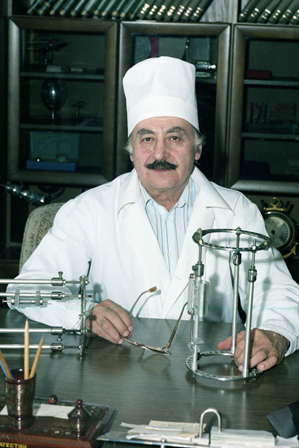
Prof Gavriil A. Ilizarov
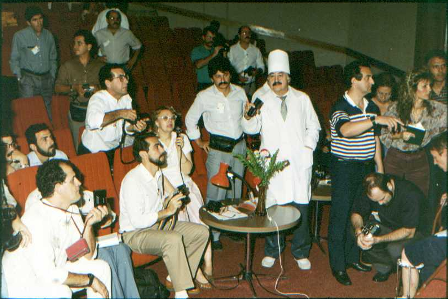
Ilizarov Workshop in Kurgan
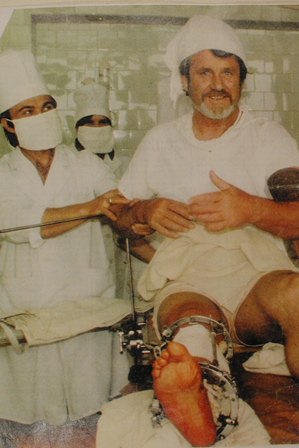
With Karlo Mauri
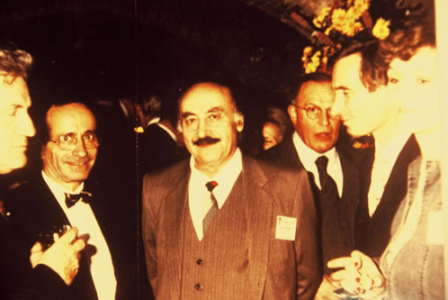
With Kempf Vidal at SOFCOT
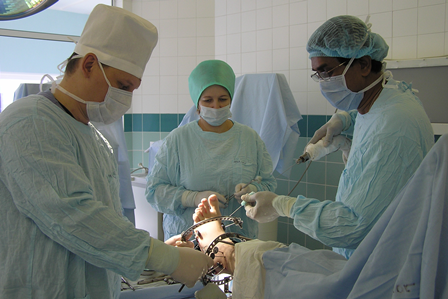
Operating room at Kurgan
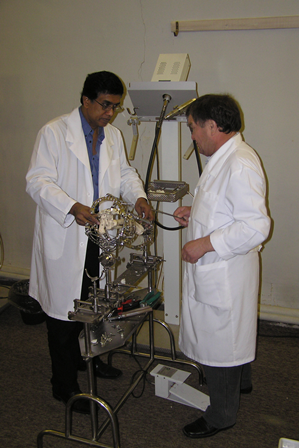
Laboratory at Kurgan